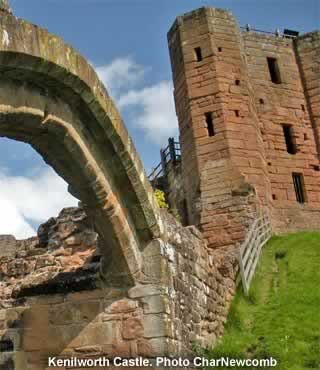Kenilworth |
|
 |
|||
Britain > West Midlands > Carrickfergus Castle |
||
A Warwickshire town that once had the strongest castle in the county |
||
Kenilworth started its life over a millennium ago, as a tiny village in Warwickshire. Over the years, it grew into an important town in medieval England. This change was mainly due to Kenilworth Castle, a 12th century fortress that was a formidable stronghold. Its defences included a huge man-made lake that surrounded the walls. This was the biggest moat in England, and it made the castle an extremely difficult place to attack. Kenilworth remained important for several centuries. The castle contains structures from all eras of British history, including a Norman keep, and Tudor gardens. |
||
Kenilworth's most prosperous time was in the 16th century, when Queen Elizabeth made several visits. In those days the castle's lord was a man called Robert Dudley, who put on the most lavish entertainment that he could afford. The Queen was dazzled by an array of pageants, banquets and performers. This went on for three weeks, almost bankrupting Dudley completely. The festivities were unlike anything England had ever seen, and people came from miles around just to catch a glimpse. One of these witnesses may have been a certain William Shakespeare. It's rumoured that the occasion inspired him to write A Midsummer Night's Dream. The pageants also feature in Sir Walter Scott's famous 19th century novel, simply titled "Kenilworth". The castle was severely damaged during the English Civil War, but is still considered to be one of the country's finest ruins. |
||
Every year, a race is held between Kenilworth Castle and Warwick Castle, 8 kilometres to the south. It began in 1983, when it was given the logical name of "Two Castles Run". The event has grown slowly over the year, and now attracts over 3,000 runners. |
||
The road next to the castle slopes down a hill, and turns into Kenilworth's High Street. This used to be the busy heart of the town, but nowadays it's an older area, full of historic buildings. The most famous of these is St. Nicholas' Church. It was built over 700 years ago, and it received several visits from Queen Elizabeth I. |
||
The church overlooks the Abbey Fields, a large green space that is well used by the locals. You can still see the ruins of the abbey that used to stand here. It was called St. Mary's, and at one time it had the second biggest income in Warwickshire. Today, the park's 68 acres contain a lake, a children's play area and several walking routes. |
||
The modern centre of Kenilworth is Warwick Road, on the opposite side of the Abbey Fields. This is where you'll find all the major shops and restaurants. The street is watched over by Kenilworth Clock Tower, a local landmark. |
||
Kenilworth has grown into a modern place, with all the amenities you might expect for a town its size. Nevertheless, it'll always be well known for its past, and the important events that happened here. Aside from the castle and the abbey, Kenilworth can make another curious historical boast. It was apparently the first place in England to grow a potato, shortly after Walter Raleigh brought the vegetable back from South America! |
||
|
||
Kenilworth Tourist Information Centre, Kenilworth Library, 11 Smalley Place, Kenilworth, CV8 1QG. Tel: 01926 748 900 |
||
Kenilworth Castle is open daily from 10am to 5pm (4pm in winter). Entry costs around £7 for adults, £3.50 for children. Castle Green, Kenilworth, CV8 1NE. Tel: 01926 852 078 |
||
|
Pocket Britain is optimised for use on a smartphone or tablet with internet access. All content is subject to copyright. All reasonable methods have been used to ensure information supplied is accurate at the time of publication. However, it is advisable to check information before relying on it. Privacy Policy |